Daniel A. Masters's Blog, page 3
July 25, 2025
The 51st Alabama Partisan Rangers and the Ride Around Rosecrans
Around dawnon December 30, 1862, General Joseph Wheeler’s cavalry brigade fell upon aFederal wagon train along the Jefferson Pike not far from LaVergne, Tennessee. PrivateWilliam C. Dodson of Co. G, 51st Alabama Partisan Rangers recalled the chaos of the scene as Wheeler’s men put thewagons to the torch.
“Prisoners running this way and that, hunting somebody tosurrender to, army wagons blazing, guns opposing, mules braying, etc. Some ofthe wagons were loaded with ammunition and some were set fire to while theteams of 4-6 mules were yet hitched to them, and as the fire commenced toscorch the wheelers and the ammunition to explode, you can imagine about as wilda stampede as you can conceive of. When I first rode into the circus, I noticeda pair of miles that had broken loose from a wagon. They were still hitched tothe double-tree; one had got entangled with the harness and was down with theother dragging him. As I rode out, I encountered the same pair of miles, onehaving dragged the other nearly a mile,” he wrote.
Private Dodson’s reminiscences of Wheeler’s first raid duringthe Stones River campaign first saw publication in the May 5, 1898, edition ofthe Atlanta Journal.
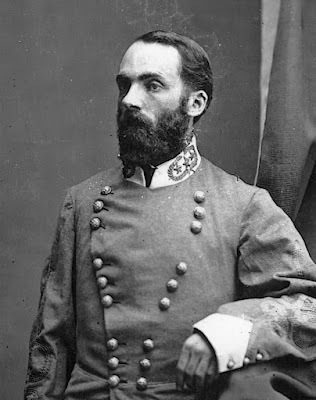 Private Dodson considered General Wheeler "an ideal cavalry commander" and noted that the general "never asked his men to go where he would not lead and for this we loved him and gladly rode with him into places where we knew all could not come out alive."
Private Dodson considered General Wheeler "an ideal cavalry commander" and noted that the general "never asked his men to go where he would not lead and for this we loved him and gladly rode with him into places where we knew all could not come out alive." In response to your request for somereminiscences of General Wheeler, my old commander, I will say that I was capturedin 1863 just preceding the Battle of Chickamauga so I cannot tellyou from personal knowledge anything of his campaigns after that date. However,I was with General Wheeler before and after the Battle of Murfreesboro, it has occurred to me that possibly some of his doings during thatmemorable engagement might be of some interest to your readers. Of course, therecollections of a private must be more personal than historical and I trust Iwill not be accused of egotism if I am compelled to use the pronoun “I” ratherfrequently.
The Battle of Murfreesboro has alwaysseemed to me the most deliberately planned of any during the war and shouldhave resulted in a greater victory than we achieved. General Bragg seemed tohave selected his own ground, entrenched himself, and then sent his cavalryunder General Wheeler to bring on the engagement. We skirmished with theFederals for several days, gradually falling back and “tolling” them on to thebattleground already selected. Toward the last the enemy “tolled” rather toofreely for comfort and on the afternoon before the battle we were glad togallop through the infantry lines to escape a shower of bullets.
The night preceding the battle we weremarched a little distance from Murfreesboro and encamped. We were allowed tofeed our horses, snatched a bite to eat and a little rest for ourselves, but nosaddles were removed and profound silence was commanded. At about midnight, wewere mounted and on the march, but what our destination was we had not theslightest idea. The campfires of the enemy were in plain view and it seemedthat we were marching directly toward them. I remember thinking that if we wereto charge the enemy’s line what a mess we would make of it in the darkness notbeing able to distinguish a Yankee from a Rebel. In fact, it was the darkestnight I remember before or since. We literally could scarcely see our handsbefore our faces. We forded Stones River and I could not see the water butcould hear it gurgling and hissing and could feel it halfway up my horse’ssides. We rode on during the night and as day began to dawn, I commencedlooking for some landmark to indicate where we were. Imagine my amazement whenI discovered we were in the outskirts of LaVergne which I knew to be 15 miles inthe rear of the Federal army.
Our regiment (Colonel John T. Morgan’s51st Alabama Partisan Rangers) rode second in the command and it wasnot long before we heard music ahead. Any old soldier will know that by music Imean the clatter of musketry, punctured with an occasional boom of cannon.Presently a courier came back to order up another regiment, which was ours, andwe went in with a whoop. The fighting was about over for there was but a smallforce to oppose us which we brushed away with scarcely a halt. But the fun hadjust commenced.
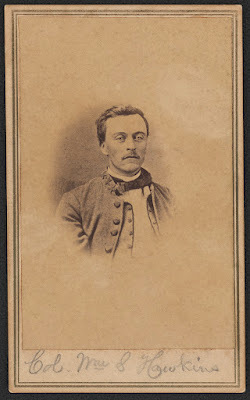 Colonel William S. Hawkins served on Wheeler's staff during the raid and one Federal recalls that Hawkins was the officer who administered the battlefield paroles to the prisoners.
Colonel William S. Hawkins served on Wheeler's staff during the raid and one Federal recalls that Hawkins was the officer who administered the battlefield paroles to the prisoners. Prisoners running this way and that,hunting somebody to surrender to, army wagons blazing, guns opposing, mulesbraying, etc. Some of the wagons were loaded with ammunition and some were setfire to while the teams of 4-6 mules were yet hitched to them, and as the firecommenced to scorch the wheelers and the ammunition to explode, you can imagineabout as wild a stampede as you can conceive of. When I first rode into the circus,I noticed a pair of miles that had broken loose from a wagon. They were stillhitched to the double-tree; one had got entangled with the harness and was downwith the other dragging him. As I rode out, I encountered the same pair ofmiles, one having dragged the other nearly a mile. One of dismounted and cutthe ham strings when muley jumped up as nimbly as if he had just been takingthat sort of ride for his health and was not in the least injured.
I was riding a borrowed horse and myfirst care was to provide one of my own at Uncle Sam’s expense. This I did, gothim safely to camp, and rode him to the end which came for me less than a yearafter. Our orderly sergeant captured the finest mule I have ever seen, amagnificent iron gray about 16 hands high and beautifully proportioned. He wasnaturally very proud of his capture until someone yelled, “Tom, look at yourmule’s eyes.” One glance and he dropped the halter like it was hot- the mulewas blind as a bat!
Of course, we were not there to stayas our position within a few miles of an army of 15,000 infantry was not one tohold. So we collected our prisoners and rode on to safe quarters. Duringthis battle, General Wheeler’s command made two complete circuits around therear of the Federal army, and partially a third which was not altogethersuccessful as the Yankees had prepared for us and we were repulsed. [See "A Gallant Defense: The 1st Michigan Engineers and the Fight for LaVergne."]
I was also with the second raid inwhich we lost some men but captured more prisoners than at the first. I startedwith the third raid but was compelled to return on account of a lame horse- thethird that I had rode down in that campaign for Wheeler’s “critter company”didn’t know much about walking horses in those days, a gallop being our usualgait. On the second raid, among the prisoners was a fellow we had mounted on anold gray mare which had belonged to one of our company who had been killed inthe melee. She was a very rough-gaited critter and while the other horses werein an easy lope, the old mare was in a long swinging trot and the poor Yankeewith his feet out of the stirrups clinging for dear life to the saddle andbouncing about 6 inches from his seat at every jump the old mare made wasridiculous in the extreme. I rode up by his side and remarked, “My friend, itseems you are not accustomed to riding.” The poor fellow replied between gasps,“Yes, I’ve rode in a buggy and in a carriage but never rode like this.”
It is not safe to trust memory afterall these years but my recollection is that the results of this campaign ofGeneral Wheeler’s were the destruction of 1,010 wagons and contents, nearly athousand prisoners, remounting many of his men who needed fresh horses, and thecapture and destruction of a gunboat on the Cumberland River. We had the wholeFederal army without rations for nearly three days. There was a citizen ofAtlanta who was a paymaster in the Federal army and one day he remarked to methat at the Battle of Stones River he had $100,000 in his safe and couldn’t buya pone of cornbread. Of course, I reminded him that I was one of the boys whohad helped destroy his rations!
As I said before, I can tell butlittle about General Wheeler’s subsequent campaigns but the above is a fair sample.To me, he was and is the ideal cavalry commander and I cannot help feeling personalpride in the fact that my old commander is one of the first for Uncle Sam tocall into service. In my youthful eyes, such men as Wheeler, Stuart, and WadeHampton “seemed giants and manhood’s more discriminating gaze see themundiminished.” General Wheeler never asked his men to go where he would notlead and for this, we loved him and gladly rode with him into places where weknew all could not come out alive.
Source:
“Soldieringwith Wheeler on Murfreesboro Field,” Private William Cary Dodson, Co. G, 51stAlabama Partisan Rangers, Atlanta Journal (Georgia), May 5, 1898, pg. 8
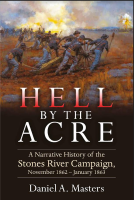
To learn more about the Battle of Stones River, be sure to purchase a copy of my campaign study Hell by the Acre, recently awarded the Richard B. Harwell Award from the Atlanta Civil War Roundtable as best Civil War book of 2024. Available now through Savas Beatie.
July 19, 2025
Crashed Over the Dam as the Bands Played On: Escaping Red River Aboard the Mound City
By the time the gunboat U.S.S. Mound City made it down the Red River in May 1864, the ironclad had to dump much of its armor and 13 guns to get through the low waters. Reading the following letters from Engineer John Harnett, his determination and simple faith in success come through strongly, as well as a sense of the surreal.
A prime example is his description of how the Mound City got over the falls of the river at Bailey's Dam. "The fall was eight feet; the break just large enough for the boats to pass through," he said. "As ours was the first boat over the falls, we were the first ordered over the dam. We went out into the stream and got a good start and headed all right, put 150 lbs of steam to her, and down she went, burying herself completely and striking the rocky bottom with such great violence that she immediately stopped. Our rudder unshipped and the water roared over us in a perfect torrent. Had we not taken the precaution to close and batten all our ports and hatches, we would have been filled with water."
"After surging a minute or two, the current carried us down all right but we are strained very badly. It was a tremendous undertaking, however, we all got over safe except the Eastport. We also lost 13 guns which are exploded and our iron plating. I feel very sorry to lose the iron but I think we will be able to stand a good fight yet. I should mention that the dam was built of coal barges and log cribs filled and sunk with brick. Brass bands were playing on each side of the river as we passed over and tens of thousands of soldiers gave us cheer after cheer as we made the plunge," he wrote.
The Waukegan Weekly Gazette presented Engineer Harnett's letters thus: “We havebeen furnished the following letters from Mr. John M. Hartnett, U.S.N., writtento his wife during and succeeding the period when Admiral Porter’s naval fleetwas detained upon the Red River by low water,” the editor of the WaukeganWeekly Gazette stated in the introduction to this article. “Some of theletters bear rather remote dates, still they are very interesting, giving aclear account of the trials of our army and navy during that memorable periodand although somewhat old, will repay a perusal.”
“The Banks expedition will go down toposterity as one of the dark spots in the history of this war,” the Gazettecontinued. “The following letters, with those already published in thesecolumns from Mr. Harnett, will convey to the reader a pretty correct idea as tothe part taken in this expedition by the navy under Admiral Porter.” Theseletters first appeared on the front page of the June 11, 1864, edition of the WaukeganWeekly Gazette.
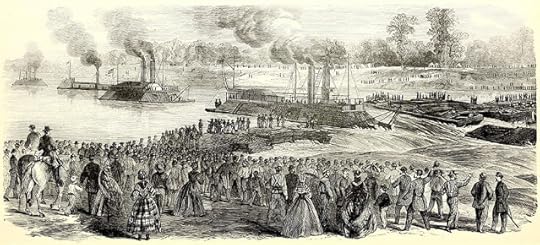 This depiction of the U.S.S. Mound City passing through Bailey's Dam on May 12, 1864 was perhaps the most dramatic episode of the vessel's time on the Red River. Caught by low water with Confederate forces nearby angling to capture the boats, one intrepid Union colonel devised a dam to raise the water level enough to allow the deep draft gunboats to continue downriver.
This depiction of the U.S.S. Mound City passing through Bailey's Dam on May 12, 1864 was perhaps the most dramatic episode of the vessel's time on the Red River. Caught by low water with Confederate forces nearby angling to capture the boats, one intrepid Union colonel devised a dam to raise the water level enough to allow the deep draft gunboats to continue downriver. U.S.S.Mound City, abovethe falls, on the Red River near Alexandria, Louisiana
April 28,1864
A fight is now going on only a fewmiles to the west of us. Musketry can be heard very plainly. Word came to usthat the Rebels were advancing with 150 pieces of artillery on one side and 30pieces on the other side of the river. We cannot get below the falls, there notbeing enough water to float any of the ten boats lying here together, almosthelpless. We cannot move up or down. We are all anchored in the middle of theriver in line of battle awaiting events which will soon come. One thing is certainthat this fleet will not be given up without being blown up first. I suppose theenemy will cut off our supplies below is by planting batteries on the riverbankso as to stop all boats from coming up. Everything looks dubious but I hope forthe best.
We have already lost five boats abovehere. The Eastport, one of our best boats, was snagged. Two steamboatswith steam pumps went up to pump her out and raise her which they succeeded in doingbut had got but a short distance down the river when she struck a bar and couldnot be got off. The Rebels, taking advantage of her helpless position, kept aconstant fire on her and the two steamboats above mentioned that pumped herout, the Champion No. 3 and No. 5. Those two boats were kept forthat purpose only and were very valuable in that capacity. The Eastportwe had to blow up. The enemy boarded the two Champions and took withsome of our officers and men on board a large lot of Negroes. Many of themthrew themselves into the river and were drowned while most of those on boardwere slaughtered.
The other two boats, which weretransports, were burned. The boat the admiral was on (the Cricket)received 27 shots and had six men killed. The Rebels had captured 17 guns fromBanks, amongst which was the Chicago Mercantile Battery and Nim’s Battery from Massachusetts and our own ammunition. They whippedBanks and drove him from Pleasant Hill to Grand Ecore and from there to thisplace. Flushed with their success, they think that we are penned in here andwill become an easy prey for them, but you can rely on it: the Red River waterswill become redder than they are now before these boats change hands. Banks,Hunter, and McClernand are here. What force we have I cannot tell. About 4,000under McClernand arrived yesterday; some more are expected from Texas andperhaps the 37th Illinois will be with them.
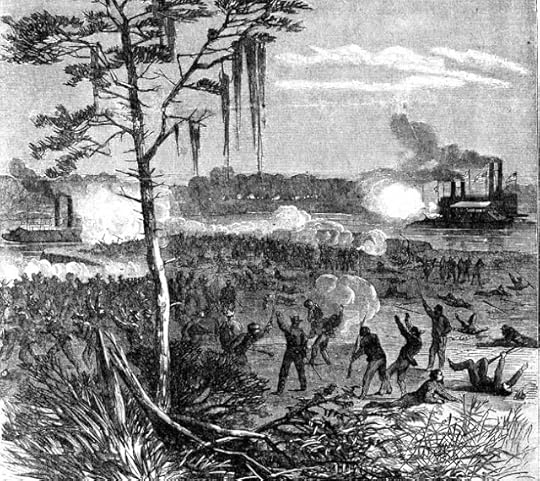 Engineer Hartnett reported that Confederates harassed the stranded gunboats "in a thousand different ways such as fire rafts, torpedoes, night attacks, etc."
Engineer Hartnett reported that Confederates harassed the stranded gunboats "in a thousand different ways such as fire rafts, torpedoes, night attacks, etc." May 1, 1864
The fight did not amount to much theother day, still it give Banks an awful scare, so much so that he formed threelines of battle two miles back of here. Skirmishing continued all day. The Rebsin the meantime were flanking him, showing a bold front to cover their realobject.
General A.J. Smith has crossed to the east side of the riverto capture some of the enemy who have gone down the river to blockade it, cutoff our supplies, and capture transports. He is a fighting man and he has theconfidence of all fighting men. He does not furnish the enemy with supplies butgets his supplies from the country he is in; nor does he deal in cotton. Histroops actually love him and would go through fire and water with him. He hasdone all the successful fighting and captured all the prisoners and guns thathave been captured in this expedition.
Banks now wants to leave and take his army with him. Theadmiral in conversation with him the other day told Banks that he was orderedup here with his fleet to give him all the protection he wanted on the water.He had done so and now the river had become so low that the fleet could not getover the falls and were in a measure helpless as our supplies would not lastlong. If our supplies were cut off, ammunition expended, constantly harassed byRebels in a thousand different ways such as fire rafts, torpedoes, nightattacks, etc. Protected as they are by the high banks and the levee, the lastresort would come and that is to blow up our vessels and every man for himself.
Banks has given up command of the army to General McClernandof Illinois who is to stay here until the fleet can get out. Yesterday, ColonelBailey commenced to dam the river below the falls so as to raise the watersufficient to carry us over. It is through it will be complete in ten days. Ihope it may.
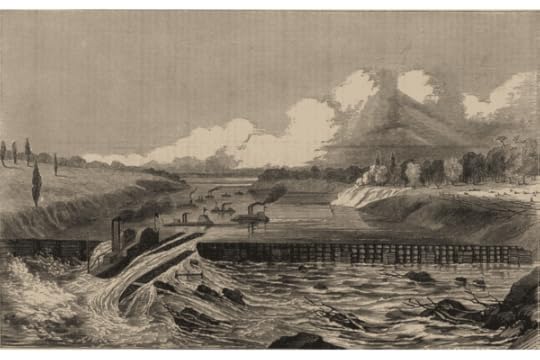 Bailey's Dam on the Red River
Bailey's Dam on the Red River40 milesbelow Alexandria, Louisiana
May 14, 1864
We finally succeeded in getting overthe falls on the 12th. The army and the navy together built a damacross the river below the falls to raise the water on the falls about threefeet. We succeeded in completing the dam but the current became so rapid that apart of it was carried away before we could get any of the heavy boats such asours over. Then we had to go to work night and day and build two wing damsdirectly on the falls that only partially succeeded after trial. We had ordersto take some of our guns and iron plating off for the purpose of lightening theboats as much as possible. After bursting all the guns we took off, we got overand down the dam that night.
The next thing was to jump the dam.The fall was eight feet; the break just large enough for the boats to passthrough. As ours was the first boat over the falls, we were the first orderedover the dam. We went out into the stream and got a good start and headed allright, put 150 lbs of steam to her, and down she went, burying herself completelyand striking the rocky bottom with such great violence that she immediatelystopped. Our rudder unshipped and the water roared over us in a perfecttorrent. Had we not taken the precaution to close and batten all our ports andhatches, we would have been filled with water.
After surging a minute or two, thecurrent carried us down all right but we are strained very badly. It was a tremendousundertaking, however, we all got over safe except the Eastport. We alsolost 13 guns which are exploded and our iron plating. I feel very sorry to losethe iron but I think we will be able to stand a good fight yet. I shouldmention that the dam was built of coal barges and log cribs filled and sunkwith brick. Brass bands were playing on each side of the river as we passed overand tens of thousands of soldiers gave us cheer after cheer as we made theplunge.
We remained at Alexandria only longenough to take in coal and ammunition; the army and the fleet all left aboutthe same time. It would have been impossible for either one to get away alone.The soldiers are marching along the bank and the gunboats with 40 transportsunder their protection are proceeding slowly and consciously in perfect orderso far apart that each boat protects so many transports.
Tonight, we are down to where the Rebels captured two of oursmall tinclads like the old Glide and the transport John Warner. Allof them were sunk in the river just below for the purpose of blocking the riverand prevent our getting out. They were sure they had us above the falls and Ithink they will fail here. It is reported that the Rebels are going to make astand three miles below here; they have 27 pieces of artillery and 16,000 men.We will blow up the obstructions in the river tomorrow morning if we cannotforce ourselves over without. This afternoon we had a little fight with thebushwhackers. They had fired on one of our transports, killing two or threemen. One was killed and one wounded aboard the monitor Ozark.
The army has been skirmishing all day, the enemy falling backto this point. The admiral is with us but he is unwell. I believe he is not as energeticas I have seen him and seems to be low-spirited. This is a great blow to usall; still if we get to the Mississippi with this fleet and army, the retreatwill be a masterly success.
I am afraid the Rebels will cross the river tonight and gettheir batteries on the opposite side of the river from the army and we willhave to do all the fighting alone tomorrow. If that is the case, we will havehot work on hand. We have to drink this infernal river water with human bodies,both black and white, floating in it, also dead horses, mules, and alligators.The thought alone is horrid enough. I hope we will soon get out of this scrape.The Rebels say they are going to sink and bag the whole of us. They may sinkthe boats and kill us but the bagging part is played out. We will blow ourboats up with all on board first.
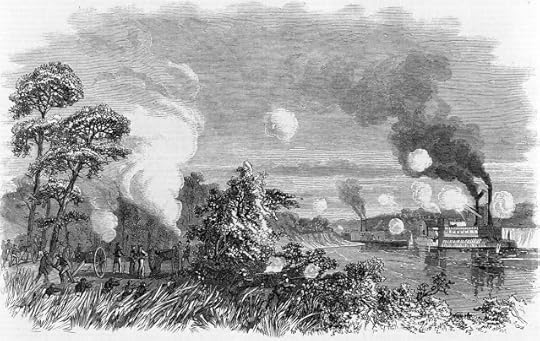 Once past the falls, the fighting wasn't over for the gunboats. Engineer Hartnett reported that his gunboat fired 291 shots before reaching relative safety on May 16, 1864; a few days later the vessel reached the Mississippi River.
Once past the falls, the fighting wasn't over for the gunboats. Engineer Hartnett reported that his gunboat fired 291 shots before reaching relative safety on May 16, 1864; a few days later the vessel reached the Mississippi River. 40 milesfrom the Mississippi River
Midnight,May 16, 1864
We have been fighting most of the dayand have cleared our way together with the transports. Our boat and two othergunboats are ahead; 8 gunboats and 36 transports are behind. All the fleet isnow safe as we are only 40 miles from the Mississippi. We will not go out tothe Mississippi for two or three days. We are to convey some troops to Simsportabout 60 miles from here. I don’t know our destination. We must go somewherefor repairs soon. I finish this with haste, hoping to be able to get in theadmiral’s boat which is nearby in the morning. He is going out of the riverimmediately. There was no one killed in our boat and we fired 291 shots.
At Simsport,Louisiana
May 19, 1864
We are here to cover Banks’ retreatacross this river on his way to New Orleans. They are now building a pontoon bridgeof steamboats, 20 in number, lying side by side across the stream- a novelsight, indeed. Go into Wheelers’ once in awhile and look at Harper’s and FrankLeslie’s pictorial papers for some good Red River scenes. General A.J. Smithwas fighting all day about six miles from here; he is bringing up the rear of Banks’army. It is supposed that the Rebels will follow to this river and attack thetransports. There are some 30 of them here and three gunboats to protect them.When we leave here it is uncertain where we will go. Two of the ironclads, Louisvilleand Pittsburgh, have been ordered to Cairo for repairs. We are in worsecondition than either of them. We will certainly go to Cairo or New Orleans forrepairs; if we do, I probably will get a chance to go home. It is likely allthe officers will.
To read more about the Mound City, please check out "Steaming Through a Hornet's Nest: The Mound City at Vicksburg."
Source:
Letters fromEngineer John M. Hartnett, U.S.S. Mound City, Waukegan Weekly Gazette(Illinois), June 11, 1864, pg. 1
July 17, 2025
Steaming Through A Hornet’s Nest: The Mound City at Vicksburg
Working inthe darkened engine room of the gunboat U.S.S. Mound City, Engineer John M.Hartnett recalled the experience as his gunboat ran the batteries at Vicksburgon the night of April 16-17, 1863.
“For about 30 minutes there was a constant stream of shotwhizzing and shells screeching over and around us, mostly over,” he noted. “Noperson that has never been under fire of batteries can have any idea of thecharming sensation produced by these shells. My position, of course, was in theengine room as it was of all the other engineers so that in case should bekilled or disabled, another could take his place. We were obliged to handle theengine in the dark as no lights were allowed on the ship, which made it verydisagreeable for us as we could not see anything that was going on outside butcould hear distinctly the shots as they passed and those that struck us.”
Engineer Hartnett’s account of runningthe batteries at Vicksburg first saw publication in the May 9, 1863, edition ofthe Waukegan Weekly Gazette.
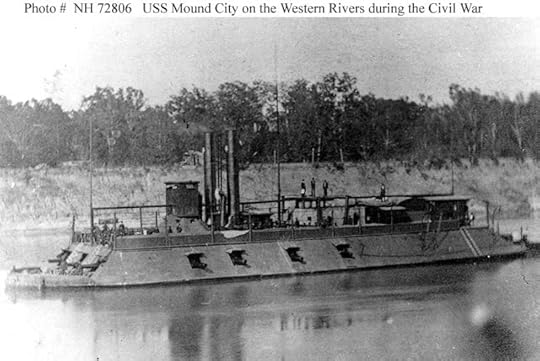 The U.S.S. Mound City was built in 1861 by James Eads and featured 2-12" armor over most of the vessel except the stern. Displacing 512 tons, the gunboat featured 13 guns and was manned by a crew of 251 officers and men. Engineer Hartnett's tale of how the vessel was nearly sunk during the Red River campaign the following spring will be featured in a future blog post.
The U.S.S. Mound City was built in 1861 by James Eads and featured 2-12" armor over most of the vessel except the stern. Displacing 512 tons, the gunboat featured 13 guns and was manned by a crew of 251 officers and men. Engineer Hartnett's tale of how the vessel was nearly sunk during the Red River campaign the following spring will be featured in a future blog post. U.S. GunboatMound City
30 milesbelow Vicksburg, Mississippi
April 20,1863
Believing that you have nocorrespondent in the fleet of Admiral [David Dixon] Porter and supposing thatany good news would be welcome. I will endeavor to give you an idea of how weran the blockade, or rather how we fought and passed the renowned stronghold ofVicksburg.
A day or two after we returned fromour expedition up Deer Creek and Steele’s Bayou, while at anchor at the mouthof the Yazoo River, we received orders to place logs on the side of our boatwhere it was not protected by iron. We did so; then orders came for us toreport to the admiral when ready. After putting about 50 bales of pressed hay onour stern and over our magazines we reported as ready on the 13thinstant. From some cause, we were delayed until the night of the 16thwhen we left our rendezvous about 9:30 in the following order: the flagship Bentonwith the Admiral on board, then the Lafayette, General Sterling Price, Louisville,Mound City, Tuscumbia, Carondelet, and the Pittsburg, each boathaving a barge of coal in tow. There were also three transports in the rear whichkept well on the opposite side of the river from the batteries. They wereprotected about their boilers with cotton bales; their names were the HenryClay, Forest Queen, and the Silver Wave. [please see “Running the Vicksburg Batteries in the Forest Queen"]
We floated down, keeping as well as wecould about 300 yards apart. The night was bright starlight; everything seemeddeathly still as if taking a long breath for what was soon to come. All handswere at their various stations waiting for the word to fire. On we went, keepingclose to the Vicksburg side. The first we heard was the roll of the drum; in amoment after crashed a volley of musketry, then the shot and shell began topour in and about each boat as it passed by.
Soon after the volley of musketry we received, the Rebelsmade a very large fire on a raft which illuminated the river so they coulddistinguish every boat perfectly while it blinded us. All we had to shoot atwas the flashes of their guns. I thought we got into a hornet’s nest in that fightat Arkansas Post where I wasfirst introduced to the music of flying shot and shell, but that was nothingcomparatively. Never were guns served more lively than the Rebels handledtheirs.
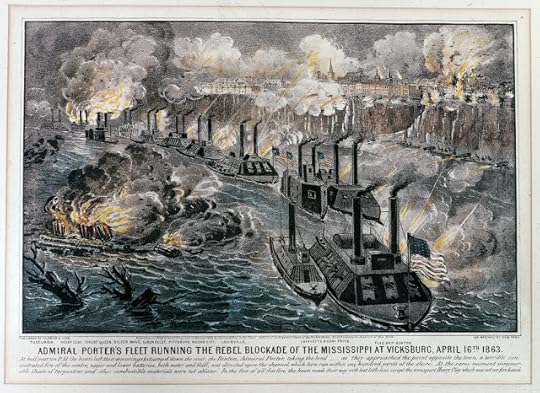 The U.S.S. Mound City was fifth in the line of eight gunboats that steamed past the Vicksburg batteries on the night of April 16-17, 1863.
The U.S.S. Mound City was fifth in the line of eight gunboats that steamed past the Vicksburg batteries on the night of April 16-17, 1863. For about 30 minutes there was aconstant stream of shot whizzing and shells screeching over and around us,mostly over. No person that has never been under fire of batteries can have anyidea of the charming sensation produced by these shells. My position, ofcourse, was in the engine room as it was of all the other engineers so that incase should be killed or disabled, another could take his place. We wereobliged to handle the engine in the dark as no lights were allowed on the ship,which made it very disagreeable for us as we could not see anything that wasgoing on outside but could hear distinctly the shots as they passed and thosethat struck us.
We received a shot in a bale of hay,one which glanced on a log, one through our side just forward of our ironplating about 6 feet above the gun deck. This last shot in passing through theship cut off an oak stanchion eight inches square, through a ventilator, outthe opposite side, doubling over as if it were tin 2-1/2” iron, falling intothe coal barge. Another shot struck the coal barge just above the water line.The shot that went through us wounded four men by splinters, all of whom willrecover.
All the boats were struck more or less. The Lafayettereceived 10 shots through her; I have heard of only one man being killed. The Louisvilleat one time ran against the shore under the batteries. The Rebels ran down thebank with planks to board her; she swung around and gave them her broadsideguns, loaded with grape and canister, and mowed them down right and left. TheTuscumbia also ran aground but got off all right. It seems that the greatlight blinded the pilots.
We might have passed the batteries inhalf the time but that was not altogether the object; it was to fight and passthem contemptuously. So, I don’t want it said that we ran the blockade.The transport Henry Clay was burned; the Forest Queen had one ofher steam pipes shot away and was towed to the other side of the river belowVicksburg and left to repair. The Silver Wave came down all right. Afterwe had passed Vicksburg a few miles, we stopped to see if all the boats weresafe before we passed the Warrenton batteries. All got in line again andsteamed down to Warrenton, running close in shore, when they opened on us withall vengeance. We poured it into them hot and fast and they soon dried up. Ithink they were badly scared as they fired but a few shots.
Our next fight will be at Grand Gulf25 miles below. The intention is to pass the batteries and fight them upstream.They have some very heavy guns there- four from the Indianola aremounted there. The remains of the Indianola lie partly above water onthe other side of the river from us. The Rebel story was that they raised herand had her in fighting trim; it is not so. I expect we will move down theriver tomorrow. We have plenty of hot work ahead; there are four Rebel rams alittle ways below us. The only way for us to get out now is to fight out. Weare now between Vicksburg, Port Hudson, and Grand Gulf.
Source:
EngineerJohn M. Hartnett, U.S.S. Mound City, Waukegan Weekly Gazette(Illinois), May 9, 1863, pg. 2
July 16, 2025
Every Man That Rose to Fire was Sure to Die: With the 3rd Vermont at Spotsylvania Courthouse
As experienced in the 3rd Vermont, the fighting at Spotsylvania Courthouse ranked among the closest fighting of their war.
"It was a hand-to-hand contest," recalled Lieutenant Frank Rew. "Our brigade, in fact our division, fought 8 hours with only a rifle pit between them and the enemy. Each party would point their guns over the breastworks and fire down at random much of the time for every man that rose to fire was sure to die. Very many here were killed with the bayonet and clubbed musket and each party would throw stones and rails over upon the heads of their opponents. One man showed me a bayonet he wrenched from a Rebel gun as it was thrust over to be fired."
Frank Rew regularly sent missives backto his parents in Illinois throughout the war starting with his regiment’sfirst engagements outside Yorktown, Virginia in April 1862 which was featured recently on the blog. This account of Spotsylvania Courthouse firstappeared in the June 4, 1864, edition of the Waukegan Weekly Gazette.
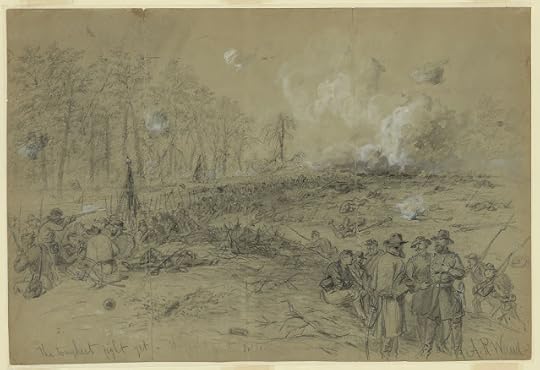 The fight at the Salient of Spotsylvania Courthouse by Alfred R. Waud
The fight at the Salient of Spotsylvania Courthouse by Alfred R. WaudCamp in thefield, Virginia
May 19, 1864
My dearparents,
Our army occupies nearly the sameposition as when I last wrote, perhaps a little advanced. We are stronglyentrenched here, not because it is the end of the campaign and the commencementof a season of inactivity, but as a precautionary measure. As soon as the armyis well rationed again and reinforcements are all up, there will undoubtedly beanother great battle. About 25,000 new troops have already arrived but thiswill not make us good yet, if they will fight, I have no fears for the result.
The battle of Thursday a week ago wasthe severest we have had. It was a hand-to-hand contest. Our brigade, in factour division, fought 8 hours with only a rifle pit between them and the enemy.Each party would point their guns over the breastworks and fire down at randommuch of the time for every man that rose to fire was sure to die. Very many herewere killed with the bayonet and clubbed musket and each party would throwstones and rails over upon the heads of their opponents. One man showed me abayonet he wrenched from a Rebel gun as it was thrust over to be fired.Finally, every Rebel in the line before our division was either killed, woundedof captured, most of them killed. Our brigade lost 800 men in this fight. Wehave now but 200 men in our regiment to show for the 600 we brought from camp.
Our division has done more fightingthan any other in the army and are still on the front; this is because the menwill not run. They boys begin to think the only way they can get on the reserveis to run in the next fight which they will not do, of course. It wouldsurprise you to see how accustomed these men have become to this deadly work.They go into the skirmishing line and crack at the enemy and receive their firewith as much composure as they would go into the cornfield with their hoe andwhen they move on the enemy or advance, the line is closed and every step assteady as on drill. It is all a matter of course now. Every man seems to feelthat his time must come sooner or later and the sooner it comes, the moremarches and battles he will escape. They are veterans in every sense of the wordand if the army was entirely made up entirely of such men, we would be in Richmondin one week, but it is not. All the prisoners that have been captured have beentaken on the part of the line occupied by our division. They fought underHancock all the first week.
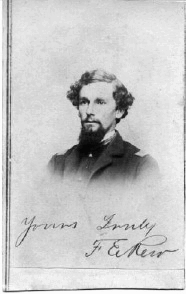 First Lt. Frank E. Rew
First Lt. Frank E. RewCo. B, 3rd Vermont
One evening last week, our divisionwas ordered to make a charge. They were relieved from the first line about noonto rest and prepare for it and every man knew what was coming. They were to “goin” about sundown and about 5 o’clock coffee was served. I saw the men eattheir hardtack and drink their coffee with as keen a relish and as littleconcern as if they were expecting a game of ball instead of a deadly fight.When the time came, each man was in his place and at the word “forward” allstepped off promptly. As they emerged from the woods in front of the positionthey were to storm the order “double quick” rang down the lines and with itrose the most unearthly shouts and yells ever heard. They received a terriblefire from the enemy but the living pressed steadily onward and in 20 minutesthe position was taken and with it, 1,000 prisoners captured. This is but oneof the many similar scenes through which we have passed during the past fewweeks and which stare us in the face in the future for the work is not yetcomplete. The shouts of a charge are unlike any sound the human voice can makeunder the circumstances and must be heard to be understood; it cannot bedescribed.
Ewell made a raid on our rear lastnight with the intention of capturing our trains but was sent back with a rush,leaving many killed and wounded and 425 prisoners in our hands. Some of thecitizens of Fredericksburg were in the plot and today 60 of them have been arrested.
To learn more about the Battle of Spotsylvania Courthouse, please check out the following posts:
We Buried 110 Men in that Half Acre: A Buckeye Remembers Spotsylvania CourthouseGrant the Great will soon be no more: An Alabamian at Wilderness and Spotsylvania Courthouse (15th Alabama)Source:
Letter fromFirst Lieutenant Frank E. Rew, Co. B, 3rd Vermont VolunteerInfantry, Waukegan Weekly Gazette (Illinois), June 4, 1864, pg. 3
July 15, 2025
Mounted for Monocacy: An Account from the 159th Ohio
Pulled from guard duty at Camp Bradford in Maryland on July 4, 1864, Private Charles Wise and 99 of his comrades of the 159th Ohio were detailed act as mounted infantry to help fend off Jubal Early's invasion of the state.
By July 9th, the detachment found itself on the far right of the Union line at the Battle of Monocacy opened. "The Johnnies formed their skirmishers in line and we did the same. Our company was ordered to advance and formed our line of skirmishers which we occupied until 4 o’clock in the afternoon when were ordered away from our posts by the captain. When we came upon the road, we found ourselves surrounded on all sides by the Johnnies and were cut off from the rest of the command. We knew not what to do, so the captain said, ‘Boys, let’s get out of here.’ We made a charge up the pike and went through the Johnnies and their fire all right and safely without harm. We retreated down the pike on the way to Baltimore. We were ordered to cover the retreat so we had to go back and give the Johnnies another volley. By that time the whole of our men were safely in front of us and we brought up the rear of the column," Wise wrote.
The following letter, a rare account fromthe 159th Ohio, provides some insights into the days leading up tothe Battle of Monocacy. It first saw publication in the July 22, 1864, editionof the Zanesville Daily Courier.
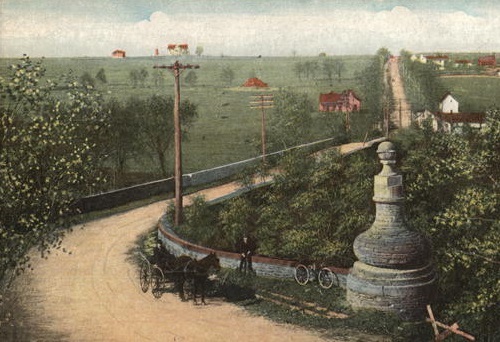 The 100-man detachment from the 159th Ohio fought on the far right flank of the Union position east of Frederick, north of Reich's Ridge pictured in this turn of the century postcard depicting the Jug Bridge.
The 100-man detachment from the 159th Ohio fought on the far right flank of the Union position east of Frederick, north of Reich's Ridge pictured in this turn of the century postcard depicting the Jug Bridge.
CampBradford, Maryland
July 18,1864
Dear mother,
It is with the greatest pleasure I nowtry to write you a few lines merely to inform you that I am well and safe backinto Camp Bradford again after the three days’ battle at Frederick and MonocacyJunction. I will give you a description of it as well as I am able.
We received orders on the night of the4th of July for 100 men to go to Frederick as mounted infantry. Adetail was made from four companies to go: Co. B furnished 40 men, Co. E 20men, Co. G 20 men, and Co. K 20 men. We were then marched down to headquartersand received orders to go to the stable and get our horses, bridles, blankets,and traps. It was 12 o’clock before we received them but we got them at lastand started for Camp Carroll. We got there just at daylight and stayed thereall day Tuesday.
On Wednesday we started for Frederick, marching all day anduntil late in the evening when we camped in the woods, staying until morning.Then we started again through the dust and scorching sun, reaching Frederickjust in time to go into the fight. We fought them until dark when we retiredfrom the field of action, laying on our arms all night ready for any emergencythat might occur.
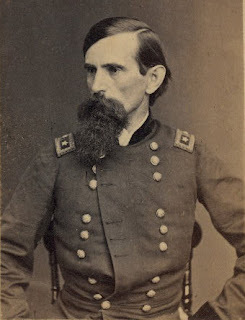 Major General Lew Wallace
Major General Lew WallaceWe slept all night without being disturbed until about 4 inthe morning when we were ordered to fall in and take up the line of battlewhich we did. We advanced and were deployed as skirmishers to bring on thefight; that was the day we made the Johnnies retreat ten miles from Frederick,but during the night they received reinforcements from Harper’s Ferry. That wason Friday night and came back upon us Saturday morning with their whole forcenumbering, as is estimated by General Lew Wallace, at 50,000 men. He was ourcommander during the engagement. Our whole force only numbered 8,000.
The Johnnies formed their skirmishers in line and we did thesame. Our company was ordered to advance and formed our line of skirmisherswhich we occupied until 4 o’clock in the afternoon when were ordered away fromour posts by the captain. When we came upon the road, we found ourselvessurrounded on all sides by the Johnnies and were cut off from the rest of thecommand. We knew not what to do, so the captain said, ‘Boys, let’s get out ofhere.’ We made a charge up the pike and went through the Johnnies and theirfire all right and safely without harm.
We retreated down the pike on the way to Baltimore. We wereordered to cover the retreat so we had to go back and give the Johnnies anothervolley. By that time the whole of our men were safely in front of us and webrought up the rear of the column. We marched all night until daybreak thenhalted for about two hours, then started again and reached Ellicott’s Millsabout noon. We stayed two days then came on to Baltimore, turned over ourhorses, and came to Camp Bradford again. We were out 14 days from camp.
To learnmore about the Battle of Monocacy, please check out these posts:
The 144th and 149th Ohio at the Battle of Monocacy
We Had to Run But We Saved the Army: With the Ohio National Guardsmen at Monocacy
More Than Recruits in the Diggins: Fighting Early at Monocacy
Taking a Bullet and Finding a Wife
Source:
Letter fromPrivate Charles H. Wine, Co. E, 159th Ohio Volunteer Infantry (National Guard), ZanesvilleDaily Courier (Ohio), July 22, 1864, pg. 2
July 5, 2025
Last Minute Reprieve at Murfreesboro
At the endof chapter 3 of Hell by the Acre, I tell the story of the military executionsthat took place at Murfreesboro on December 26, 1862. Three soldiers and onecivilian were slated for execution that day, most famously, that of Private AsaLewis of the 6th Kentucky whose execution became a cause celebrewithin the Orphan Brigade. The story of the second soldier, Edward P. Norman ofthe 28th Alabama, was also described in the book “while the finaldeserter from the 24th Tennessee received a reprieve from Bragg justas he was about to be executed.”
It was not until recently that I learned the story ofhow this Tennessean was saved at the last possible moment by the intrepidefforts of a Confederate enrolling officer.
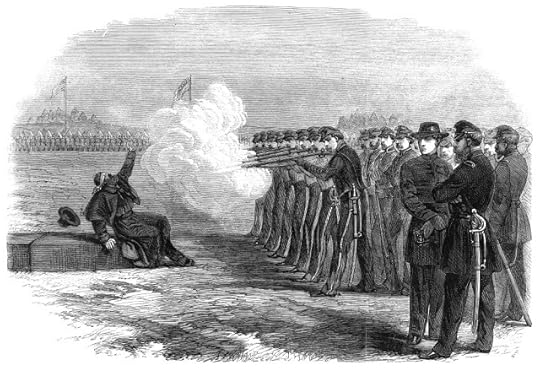 A total of three executions took place in Murfreesboro on December 26, 1862. The first was a civilian spy named Gray who was hung near the railroad depot. The military executions took place in an open field south of town where just a few weeks before President Jefferson Davis had reviewed the Army of Tennessee. Asa Lewis of the 6th Kentucky was executed first, then Edward P. Norman of the 28th Alabama. The last soldier, a member of Co. B, 24th Tennessee whose name is lost to history, received a reprieve at the last possible moment.
A total of three executions took place in Murfreesboro on December 26, 1862. The first was a civilian spy named Gray who was hung near the railroad depot. The military executions took place in an open field south of town where just a few weeks before President Jefferson Davis had reviewed the Army of Tennessee. Asa Lewis of the 6th Kentucky was executed first, then Edward P. Norman of the 28th Alabama. The last soldier, a member of Co. B, 24th Tennessee whose name is lost to history, received a reprieve at the last possible moment. Judge Frank H. Smith, writing in the Columbia Herald andMail in 1904, told the story of the Duck River Riflemen which became Co. Bof the 24th Tennessee Infantry. In that article, he writes thefollowing:
“While encamped at Murfreesboro, one of the Duck RiverRiflemen was arraigned on a charge of desertion after the Shiloh battle. Itseems that he had been given a leave of absence for several days and that timehad been extended by Colonel Allison who was then in command of the regiment.Nothing was though or done about this for some months but at Murfreesboro thematter was called up and a court martial ordered to try his case,” Smithstates.
“On this hasty military trial the proof could not be producedof the extension of his leave of absence and Colonel Allison was in a differentcommand then. Greatly to the surprise of all, he was found guilty and underBragg’s idea of strict discipline, he was sentenced to be shot the second dayafterwards. As is customary in military executions, the firing detail is madefrom the company and regiment of the condemned man and W.M. Shires, ChrisShires, George Rummage, and Sam Daimwood of the Duck River Riflemen were ofthis detail to shoot their companion,” the judge continued.
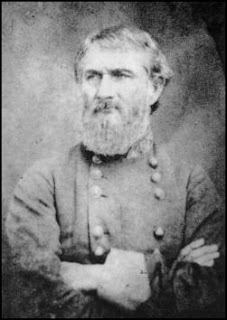 Lt. Gen. Leonidas Polk
Lt. Gen. Leonidas Polk“The execution was to take place at 4 o’clock in theafternoon; the grave had been dug, the troops of the brigade and division wereall in position on the conventional three sides of a hollow square. The wagonhad been driven up with the man seated on his coffin; the firing squad hadtaken position 10 paces in front of the doomed victim who had been blindfoldedand placed at the grave. Then an officer dashed up, his horse in a foam ofsweat, with a reprieve from General [Leonidas] Polk,” Smith related.
“Mat Reynolds had heard of this strange trial and sentence athis home in Maury County the night before. He had been the enrolling officerwith the regiment in Mississippi at the time the leave of absence had beenextended and knowing this man’s innocence of the charge of desertion, he hadridden all night and well into the day, nearly killing his horse in the effortto reach Murfreesboro. He had barely time to make his statement to General Polkand for the general to send a staff officer with the reprieve. The sentence ofthe court martial was reversed and an honorable discharge granted, and today heis living near Kedron in Maury County, a highly respected man in the community.He says he knows exactly how a dead man feels for he considered himself a deadman.”
And other than knowing the name of thesoldier in question, we know the “rest of the story.”
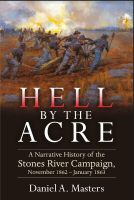
To learn more about the Battle of Stones River, be sure to purchase a copy of my campaign study Hell by the Acre, recently awarded the Richard B. Harwell Award from the Atlanta Civil War Roundtable as best Civil War book of 2024. Available now through Savas Beatie.
Sources:
Masters,Daniel A. Hell by the Acre: A Narrative History of the Stones River Campaign,November 1862-January 1863. El Dorado Hills: Savas Beatie, 2024, pg. 94
“The DuckRiver Riflemen,” Judge Frank H. Smith, Columbia Herald & Mail(Tennessee), April 15, 1904, pg. 1
July 4, 2025
It Made the Air Hideous: At Chickamauga with the 51st Illinois
By the time the 51st Illinois arrived on the field of Chickamauga on the afternoon of September 19, 1863, the battle had already been raging for hours and, at least in the part of the field the regiment arrived upon, the battle seemed to be going against the Army of the Cumberland. As a matter of fact, the Confederates had just overrun the 8th Indiana Battery.
"We were surprised to see the enemy in such force, but as we were ordered to advance and take back the battery, there was no time lost in thinking the matter over," stated Orderly Sergeant Charles Strickland of Co. G. "The 22nd and 42nd Illinois regiments were ordered to advance and as the brave veterans moved steadily forward, we could see the enemy unfurl their battle flags and cheer after cheer filled the air with repeated echoes which was followed by their shells which came screaming through the air. The distance was not half a mile and as they advanced, the enemy fired with great rapidity."
"They poured such heavy muttering volleys from their double columns in our single line that they made wide gaps in our line which, without support, could not be closed. So, they were obliged to lay down to hold what ground they had gained. Then Colonel Luther Bradley commanding the brigade, as brave a man as ever tread beneath a flag, came riding in front of his regiment [51st Illinois] with hat in hand and gave the order to forward, then the command to charge. In double quick and with a shout which mingled with the roar of battle, they charged," he continued.
Sergeant Strickland’s account of the firstday’s fighting at Chickamauga first saw publication in the November 7, 1863,edition of the Waukegan Weekly Gazette.
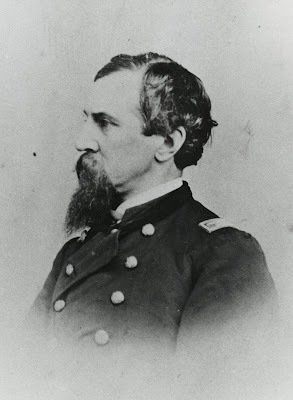 Colonel Luther P. Bradley assumed command of the Third Brigade of Sheridan's division at Stones River after its previous commander Colonel George W. Roberts was killed in the final stages of the division's fight for the Wilkinson Pike.
Colonel Luther P. Bradley assumed command of the Third Brigade of Sheridan's division at Stones River after its previous commander Colonel George W. Roberts was killed in the final stages of the division's fight for the Wilkinson Pike. Chattanooga,Tennessee
October 11,1863
Friend Cory,
I seat myself to give you a detail ofthe movements of the Third Brigade of Sheridan’s division at the Battle ofChickamauga on September 19. We were first formed in line on the right but soonthe roaring of cannon and volleys of musketry could plainly be heard on theright center. We then received orders to move that way and went at a doublequick; reached the place just in time to see the enemy drive our men back andtake possession of the 8th Indiana Battery.
We were surprised to see the enemy insuch force, but as we were ordered to advance and take back the battery, therewas no time lost in thinking the matter over. The 22nd and 42ndIllinois regiments were ordered to advance and as the brave veterans movedsteadily forward, we could see the enemy unfurl their battle flags and cheerafter cheer filled the air with repeated echoes which was followed by theirshells which came screaming through the air. The distance was not half a mileand as they advanced, the enemy fired with great rapidity.
They poured such heavy mutteringvolleys from their double columns in our single line that they made wide gapsin our line which, without support, could not be closed. So, they were obligedto lay down to hold what ground they had gained. Then Colonel Luther Bradleycommanding the brigade, as brave a man as ever tread beneath a flag, cameriding in front of his regiment [51st Illinois] with hat in hand andgave the order to forward, then the command to charge. In double quick and witha shout which mingled with the roar of battle, they charged.
Then the cannonading commenced. The fireof our guns drew a most terrific one from the enemy’s entire line. I thoughtthat I had heard the roaring of battle before when at New Madrid, Island No.10, Tiptonville, Farmington, Corinth, Nashville, and Stones River, but I neveryet heard such tremendous firing. It made the air hideous and shook the veryearth beneath us. The hills and mountains seemed to reel like drunken men.
“Weleft Bridgeport, Alabama on the 2nd of September and made some veryheavy marches over those mountains of Georgia through the dust and heat but gotinto no fight worthy of mention until Saturday the 19th when we wentin about 4 p.m. We were ordered to charge into a cornfield and a strip of woodon the north side of the field. Three brigades had charged in succession beforeus and had been repulsed every time. We went in and was in there some 15minutes when we had to fall back as the others did. Sergeant D. Burr Ackley of Forksville was oneof the color bearers and the flag that he carried was shot clear from the staffyet he came out unhurt till the next day when he was instantly killed.” ~Sergeant Cornelius F. Bliss, Co. G, 51st Illinois
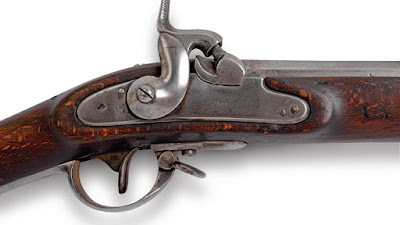 The 51st Illinois carried a mix of arms at Chickamauga but .54 caliber Lorenz rifle muskets predominated.
The 51st Illinois carried a mix of arms at Chickamauga but .54 caliber Lorenz rifle muskets predominated. For some time, this most terrific fire continued and thecontest raged with intense fury, during which time the shrieking of shells, thecrash of falling timber, the fragments of rock flying through the air shatteredfrom the cliffs by solid shot and shell. The canister and bullets flew likehailstones in water. Men were falling like leaves when shaken by the blasts ofautumn amid the fierce neighing of the many wounded artillery horses. I sawmany a Rebel flag go down but how quickly they again mounted the breeze throughthe dense columns of smoke which were rising upward then slowly floating away.
Our colors that were shot down threetimes at Stones River were completely severed from the staff, but the latterwas carried high and proudly amid the wild tempest of that terrible day. Thesun hid itself behind Lookout Mountain as if loth to look back upon the sceneand witness such inhumanity- all of which made a terrible picture which my penfails to describe.
Thus, daylight died away and evening with darkness came butnot rest for the vast pulsing heart of the army knows no rest. We held thefield that night and under the fire of the enemy’s sharpshooters we succeededin carrying off our wounded, drawing off the 8th Indiana Battery,and carrying with us a Rebel flag belonging to the 24th Alabama Tigerswhich has inscribed on it, “In God is Our Trust.” One company entered theengagement with 30 men and had 6 killed, 12 wounded, and 5 taken prisoner. Ourregiment now numbers 10 officers and 150 men for duty with Major [Charles W.] Davisin command.
We are encamped in this noble city which consists of widestreets and large vacant lots, although there are some very nice buildings andlarge manufacturing establishments, the largest I have seen in the South. Wehave two lines of entrenchments and some very good forts erected with gunswhich point out over the walls, big enough for smokehouses. There is verylittle or no firing on the picket line but our batteries exchange shots withtheirs very often. Their signal corps were stationed on Lookout Mountain inplain sight of us all until yesterday when they were obliged to leave onaccount of our shells.
I visited the 96th Illinois the other day and wasrejoiced to meet so many of my old Lake County acquaintances. But I did notintend to impose on you with such a long uninteresting letter, so I will close.
Very respectfullyyours,
Charles E.Strickland
OrderlySergeant Strickland would be killed in action during the assault at KennesawMountain on June 27, 1864.
To learn more about the Battle of Chickamauga, please check out my Battle of Chickamauga page which includes links to the 100+ blog posts describing various aspects of the bloodiest battle in the western theater.
Sources:
Letter fromOrderly Sergeant Charles E. Strickland, Co. G, 51st IllinoisVolunteer Infantry, Waukegan Weekly Gazette (Illinois), November 7,1863, pg. 2
Letter fromSergeant Cornelius Freeman Bliss, Co. G, 51st Illinois VolunteerInfantry, Waukegan Weekly Gazette (Illinois), October 3, 1863, pg. 2
July 3, 2025
They Rode Into Our Works: With Casement’s Brigade at Franklin
Positioned in the left center of the Federal line at the Battle of Franklin, Colonel John Casement's brigade bore some of the heaviest attacks of the engagement. Captain James S. Putnam, serving on Colonel Casement's staff as acting assistant adjutant general, wrote three letters home to his wife in Illinois describing his experiences.
"The enemy formed under cover of a wood and advanced in columns driving in our front line without firing," he wrote. "As soon as they had all got inside our works and when the enemy was within 200 yards, we opened a murderous fire of musketry, grape, and canister that from the batteries plowed at various points along the lines. Still, they continued to advance till in many places they actually reached our works. At the 23rd Indiana Battery, they came right into the embrasures and were knocked down by the men with the spikes of the guns. The 104th Ohio, a regiment of the First Brigade placed on our right, gave way at one time and for a moment things looked a little dubious, but in the next moment two fresh regiments were sent into the line thus left vacant and the advance of the enemy was soon checked. But they would rally and come again under such a fire as it seemed no single man could find a place to stand in and not get killed."
Captain Putnam’s accounts first sawpublication in the December 10, 1864, and December 24, 1864, editions of the WaukeganWeekly Gazette.
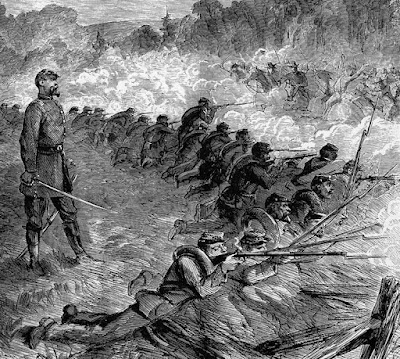 "The 23rd Corps withstood the long, continued, most persistent, and furious attack of two corps of the Rebels led on by officers of unequalled daring and bravery who rode on to our works," Captain James Putnam of the 65th Illinois observed. "They were shot down by our pistols, their men following them and their brains beaten out with our muskets."
"The 23rd Corps withstood the long, continued, most persistent, and furious attack of two corps of the Rebels led on by officers of unequalled daring and bravery who rode on to our works," Captain James Putnam of the 65th Illinois observed. "They were shot down by our pistols, their men following them and their brains beaten out with our muskets." Camp ofSecond Brigade, Nashville, Tennessee
December 1,1864
Dear wife,
I am most happy to be able to writeyou at this time for I know the newspaper reports of our battle yesterday willvery naturally cause you unusual anxiety on my behalf. We fought yesterday oneof the most bloody and, on the part of the enemy, one of the most desperate andterrible battles the history of this cruel and wicked rebellion has yetfurnished.
We had retired from Columbia the night before and wereclosely followed by the enemy who in that act probably greatly erred in hisestimate of the strength of our works of defense which we constructed in thespace of three hours time. These were, nevertheless, quite formidable and itwas reserved for the 23rd Army Corps then and there to make its markand win a proud and enduring fame. We were supported by the First and ThirdDivision of the 4th Corps while the Second and Third Divisions ofthe 23rd Corps withstood the long, continued, most persistent andfurious attack of two corps of the Rebels, led on by officers of unequalleddaring and bravery who rode on to our works. They were shot down by ourpistols, their men following them and their brains beaten out with our muskets.
Colonel W. Scott Stewart [65th Illinois] captured one battle flag, one brigadiergeneral, and one colonel besides a number of subordinate officers and 100 men.We captured altogether some 1,500 prisoners and left 4,000-6,000 Rebel killedand wounded on the field. The roar of the artillery and the rattle of musketrywas grand and terrible and terribly destructive to the Rebels as they advancedin columns on our works. Our losses are very light; indeed, no one was hurt inthe 65th Illinois although it suffered a loss of 29 men two daysbefore in a skirmish. I had many narrow escapes but am most thankful that mylife was spared to be able to communicate again with you.
Under the cover of the night we removed to this city and itis my opinion that we have so great a loss and moral defeat upon the enemy thatany attack upon this place is altogether improbable. We have more than doublethe force here with which we fought yesterday and the result, if a battle isfought here, cannot be doubtful.
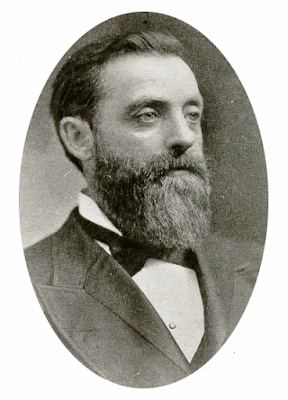 Colonel John S. Casement served as major of the 7th Ohio Infantry for about a year before accepting promotion to lead the 103rd Ohio in August 1862. His brigade, consisting of the 65th Illinois, 65th Indiana, 124th Indiana, 103rd Ohio, and 5th Tennessee, held position near the Federal center at the Battle of Franklin.
Colonel John S. Casement served as major of the 7th Ohio Infantry for about a year before accepting promotion to lead the 103rd Ohio in August 1862. His brigade, consisting of the 65th Illinois, 65th Indiana, 124th Indiana, 103rd Ohio, and 5th Tennessee, held position near the Federal center at the Battle of Franklin. Headquarters,Second Brigade, Nashville, Tennessee
December 4,1864
Dear wife,
In reference to the operations of theenemy, there is nothing particularly new. In an attempt to lay a pontoon bridgelast night, they were badly defeated and a considerable number of them werecaptured and their pontoon boats between the city and the gunboats below weredestroyed.
I will now tell you a little moreabout the Battle of Franklin. Our lines were in the form of a horseshoe fromthe river above to the river again below the town and the lines of the enemywere formed entirely around or outside of ours, connecting the same points andabout half a mile in front of us. The enemy formed under cover of a wood andadvanced in columns driving in our front line without firing. As soon as theyhad all got inside our works and when the enemy was within 200 yards, we openeda murderous fire of musketry, grape, and canister that from the batteriesplowed at various points along the lines.
Still, they continued to advance till in many places theyactually reached our works. At the 23rd Indiana Battery, they cameright into the embrasures and were knocked down by the men with the spikes ofthe guns. The 104th Ohio, a regiment of the First Brigade placed onour right, gave way at one time and for a moment things looked a littledubious, but in the next moment two fresh regiments were sent into the linethus left vacant and the advance of the enemy was soon checked. But they wouldrally and come again under such a fire as it seemed no single man could find aplace to stand in and not get killed.
Thus, they continued charge after charge till they were socompletely shattered, routed, and broken up that they could no longer preservean organization. Then they all fled in precipitate rout. Their losses areestimated at 4,500-5,000 men; of these, 1,800 are prisoners including twogenerals and about 130 other officers. I passed over the field after dark andthe dead and wounded covered the ground. Our losses are not more than 300-400and these are mostly slightly wounded.
After the battle, we crossed the railroad bridge and came onto Nashville, the enemy not following us very closely. Our division bore thebrunt of the attack and done it nobly, too. A small portion of the SecondDivision was on the left, the rest being in position on the other side of theriver while the 4th Corps was mostly there, too, only a part of ourdivision being on the right of our line. We only hope Mr. Hood will repeat hisrashness here and I think we can make an end of his army.
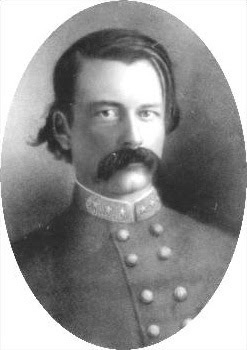 Brigadier General John Adams was struck down upon the line of works held by Casement's brigade.
Brigadier General John Adams was struck down upon the line of works held by Casement's brigade. Camp on thedefenses of Nashville, Tennessee
December 13,1864
(To theeditors of the Waukegan Weekly Gazette)
Friend Cory,
Since I wrote you last, on the 30thultimo we encountered the forces of the enemy at Franklin. This village is locatedon the Little Harpeth, a stream of no considerable dimensions over which atthis point the only crossing in on the railroad bridge. It is about 18 milesdistant from this city. Our lines were formed to cover and protect the crossingof the trains extending from Harpeth above to the Harpeth below the town. Theywere protected by a slight trench and breastwork of earth under which our braveboys anxiously awaiting the approach of the enemy while the long line of wagontrains were rapidly and in good order hurried over the bridge and hurried alongtowards this city.
Our cavalry covered the flanks thussecuring us against the possible flank movement of the enemy by crossing theriver above or below us. Skirmishing ensued early in the afternoon with theenemy’s cavalry and at precisely 4 p.m., his infantry appeared advancing incolumn. The ground in our front for a mile and a half was an undulating plainon all parts of which the movements of the enemy could be distinctly seen. Ourforces, the 4th and 23rd Corps, numbered about 25,000effective men while the three corps of the enemy (Cheatham, Stewart, and Lee)were by their own reports at least 34,000 strong.
The Rebel leader had ordered a charge. His men were brave,the officers desperate, and never did bravery and desperation continue in amore persistent and determined assault. From 4-8 o’clock, four mortal hours,did these doomed men continue in charge after charge to hurl themselves withthe irresistible fury of an avalanche upon our unyielding lines of steel andlead and iron hail. With their stars and bars planted on our parapets, thecolor bearers fell in the ditch. With their hands on the very guns of ourrifled batteries, their brains were dashed out with the hand spikes of thoseguns. They rushed upon our lines with foolhardy and frenzied desperation andthey were hurled from them in the most sanguinary, utter, and indescribable destruction.
At 8 o’clock, the battle was substantially over thoughskirmishing of a lively sort continued until after 10 p.m. At this time, ourfront lines were again advanced and we thus occupied the field of blood. Asight (or rather sounds for darkness covered the scene from view) was therewhich I hope never to encounter again. The mangled, dead, and wounded bodies ofmore than 6,000 rebels filled the ditches and covered the limited plain infront of our lines.
The Rebel General Patrick Cleburne was killed by a shell atthe very outset. Brigadier General John Adams fell in front of the gallant, veteran65th Illinois and his personal effects were collected and sent byflag of truce to his friends in the Rebel lines. Colonel William Scott Stewartwas allowed to retain Adams’ pistol as being contraband of war. Colonel Stewartalso captured a Colonel Stephens [Colonel Marcus D.L. Stephens, 31stMississippi?] with several other officers and a considerable number ofprisoners, arms, etc. The noble little Second Brigade stood firm as a rock fromfirst to last; not a man left the lines with gallantry rarely equaled andunsurpassable. Its commanding officer, Colonel John S. Casement, on seeing thelines of an adjoining brigade waver and almost break, quickly moved to the spotand by the example of his own startling energy, courage, and bravery, soonrestored the order and solidity of the lines and prevented a complete breachwhich might have proved fatal to the fortunes of the day.
General Cox, also, was in the thickest of the fight, calm andcollected as if on parade, he directed the movements of the 23rdCorps to the admiration of all, both officers and men. General Stanley,commanding the 4th Corps, is mentioned in the highest terms ofpraise and General Schofield, in a position where he could view all themovements on the field, was the master spirit, directing the whole. The losseson our part are considerable, though small when compared to those of the enemy.
In the 65th Illinois, thecasualties are but few owing chiefly to the good cover afforded by our works.And it gives me great pleasure to add that our Lake County boys, every one,escaped unhurt. The whole army did its duty bravely, nobly, well. Under coverof the night, General Schofield retired to the position we now occupy. HereHood again confronts us, but he keeps at a very respectable distance andappears to be in no hurry to repeat the Franklin tactics.
Our forces have been augmentedsomewhat since reaching this point and all are now hopeful, confident, naydefiant. “Let Hood come and the sooner the better,” say the boys. And so sayall of us, let him come. Weather very wintry the past three days as snow andice abound. More as time permits.
Very trulyyours,
James S.Putnam
Captain, 65thIllinois Vols, A.A.G., Second Brigade, Third Division, 23rd ArmyCorps
To learn more about the Battle of Franklin, please check out the following posts:
10 Days to Franklin: The 183rd Ohio Goes to WarA Buckeye Surgeon Behind the Lines at Franklin (118th OVI)Awful Scenes of Carnage: A Buckeye Recalls Franklin (26th OVI)Awful to the Extreme: Voice from the 125th Ohio at FranklinAt the Center of Hell: The 100th Ohio at Franklin Fighting with Axes, Picks, and Sponges with the 6th Ohio BatteryPandemonium Reigned Supreme: A Buckeye Captured at FranklinVignettes of the Battle of FranklinFirm as an Iron Pillar: A Hoosier Describes the Battle of Franklin (129th Indiana)The Horrors of War on All Hands: The "Fighting Parson" of the 79th Illinois Recalls FranklinHold the Bridge at All Hazards: The Last Stand on the Duck River at Columbia (22nd Indiana Battery)Source:
Letters fromCaptain James S. Putnam, Co. F, 65th Illinois Volunteer Infantry (ondetached duty as Assistant Adjutant General on Colonel John S. Casement’sbrigade staff), Waukegan Weekly Gazette (Illinois), December 10, 1864,pg. 3; also, December 24, 1864, pg. 2
July 1, 2025
Combat and Feral Hogs: A Georgian Remembers the Horrors of Stones River
For CorporalWalter B. Smith of the 3rd Georgia Infantry Battalion, the ending ofthe fighting at Stones River replaced the horrors of combat with a perhapsunexpected menace: a band of roving hogs.
His brigade had gone into bivouac in the cedar forest and as “thefighting now ceased for the day on the part of our division we soon foundthat we had a far different enemy to contend with- a drove of wild hogs hadcommenced to devour the dead and wounded,” Smith recalled in 1902. “They seemedperfectly crazed by the taste of human flesh. The writer saw several fightingover the arms and entrails of the dead. The wounded and dead were soon gatheredup and it was necessary to put guards around them with fixed bayonets in orderto keep off the hogs.” Confederate burial details started work that night, inpart to get the bodies underground before the hogs could get at them as Smithobserved.
Corporal Smith’s gritty memoir of Stones River first sawpublication in the June 15, 1902, edition of the Montgomery Advertiser.
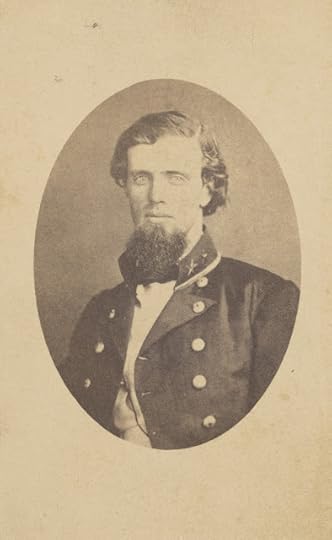 Brigadier General James Edward Rains was the first Confederate general killed during the Battle of Stones River. Leading a brigade in McCown's division consisting of the 11th Tennessee, 29th North Carolina, and the 3rd and 9th Georgia Infantry Battalions, Rains' men took part in the initial attack that broke the Union right and continued north until they tangled with John Beatty's Federals then the 36th Indiana of William Grose's brigade in the cedar forest north of the Wilkinson Pike. The young Nashville native was killed, likely by a soldier in the 36th Indiana, after complimenting the 29th North Carolina by declaring, "I will bet my black horse on the 29th."
Brigadier General James Edward Rains was the first Confederate general killed during the Battle of Stones River. Leading a brigade in McCown's division consisting of the 11th Tennessee, 29th North Carolina, and the 3rd and 9th Georgia Infantry Battalions, Rains' men took part in the initial attack that broke the Union right and continued north until they tangled with John Beatty's Federals then the 36th Indiana of William Grose's brigade in the cedar forest north of the Wilkinson Pike. The young Nashville native was killed, likely by a soldier in the 36th Indiana, after complimenting the 29th North Carolina by declaring, "I will bet my black horse on the 29th." The above-named battle was the firstconflict of any magnitude that the writer was engaged in. It proved to be aterrific and bloody one and if you think it will interest your readers, you mayuse it as you did my Missionary Ridge article.
The author, with his regiment, afterfollowing General E. Kirby Smith into and out of Kentucky was hurried down toMurfreesboro to participate in the big battle that was impending and which wasfought on the 31st day of December 1862. Our brigade, with theexception of the 37th Georgia [which was formed as the consolidationof the 3rd and 9th Georgia Battalions in the spring of1863], was composed entirely of Tennesseans under the gallant young General JimRains of Nashville, as brave a man as ever lived. Marcus Stovall, then ourcolonel, commanded our battalion.
Our company was a mixture of town, country, and factory boys,several of whom could not read or write and of course could not be expected toknow much about the outside world or how people thereof looked and dressed. Butthey knew how to drill and fight. Out of five brothers on our company’s rolls,only one could write and I believe at first they had the impression that the Yankeeswere something on the order of wild animals, for in the opening of theengagement I heard one exclaim, “I swear, they can shoot just like other folks!”
On the evening of the 30th we were thrown intoline to face some of the best soldiers the world has ever beheld. They werewestern and northwestern men, some of whom were crack shots having handled gunssince boyhood. There was a vast difference in these troops and the Federalssoldiers of the east and north, for a great many of the latter had been broughtup in workshops, stores, and factories, had never handled firearms in all theirlives before they set out to conquer us. There were also among them a largesprinkling of foreigners who did not care to sell their lives for the sake ofthe Union, but not so the western and northwestern boys for they were “true blue”and the old Confederates did not undervalue them. They knew that it was likeGreek meet Greek. The generals also realized this fact for both sides playedfor advantage and it was by gaining the advantage that we won this fight.
Rosecrans had formed his army in front of Murfreesboro withthe mass of his troops on his left with the intention of forcing Stones Riveron the north of the railroad. His right was more extended, forming something ofan angle with his center and left facing almost east. The river and Nashvilleturnpike divided his army making nearly two separate wings. Our corps [Hardee’s],composed of the divisions of Breckinridge, Cleburne, and McCown, formed theleft of Bragg’s army and were posted on the east bank of the river, extendingnearly to the Nashville road. Our army was estimated at about 40,000 effectivemen. It was the intention of the Federal general to “lick” us on the morning ofthe 31st but it was here that he got badly left.
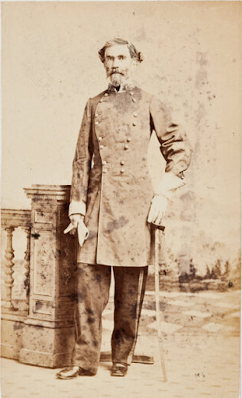 That General Bragg took umbrage with McCown's dispositions before Stones River isn't surprising given Bragg's poor opinion of McCown, once labeling him the worst divisional commander in the army. Bragg would criticize McCown in his Stones River after action report; McCown would leave the army soon after cursing Bragg and the "damned stinking cotton oligarchy."
That General Bragg took umbrage with McCown's dispositions before Stones River isn't surprising given Bragg's poor opinion of McCown, once labeling him the worst divisional commander in the army. Bragg would criticize McCown in his Stones River after action report; McCown would leave the army soon after cursing Bragg and the "damned stinking cotton oligarchy." Our brigade on the evening of the 29th was postednear the extreme left but through a mistake was posted in such a manner as toenable the enemy’s batteries to rake us from right to left. General Bragg, ondiscovering our peril, rode up with his entire staff and demanded of GeneralRains, “Who placed you here?” General Rains replied, “By order of GeneralMcCown.” General Bragg’s next order was “change it sir, so your men cannot beenfiladed,” or words to that effect. It was here that Bragg came near losinghis life for the enemy, surmising that it was some general of note with solarge a bodyguard opened fire with shrapnel and canister from a distance of not700 yards. The writer was sitting within 10 feet of General Bragg and whileBragg instinctively dodged from the shower of iron and balls that went hurtlingby Rains never moved a muscle of his face. Bragg, with his staff following him,then galloped off to a heavy piece of woods in the edge of the field. It wasthen nearly sundown. General Rains changed our position so that we fronted theenemy which made us feel much easier.
At daylight on the morning of the 31st, we wereordered to climb over the rail fence behind which we had hidden and go in a runupon the enemy’s line, not to give them a chance or time to halt or form, andnot to sound the old Rebel yell until we were right upon them. General Rains,on a powerful, large, black horse with our regimental colors in one hand, ledthe way on a gallop, not even stopping at fences, his horse jumping them whilewe just fell over them in a manner. So fast did we got that we were almost uponthe Federal pickets in the cornfield before they realized the fact and by thetime they had reached their main line, we were almost upon it.
Then, raising a terrific yell, we dashed among them, firingright and left. The enemy was so completely taken by surprise that they madebut a feeble resistance. Those that were not shot down made a wild rush for therear, leaving their breakfasts and everything else, the Confederates in fullchase and yelling for all they were worth. Through cornfields, over fences,past barns and dwellings we sped, scooping in the boys in blue by the hundredswith now and then some very funny things happening to make us enjoy the chase.It was on this run that the writer saw one very young Confederate order an oldFederal to “come out from behind that tree” and when he stepped out andsurrendered, we were surprised and amused to hear this young soldier exclaim, “Hellodad! What in thunder are you doing with them that clothes one?” He had capturedhis own father!
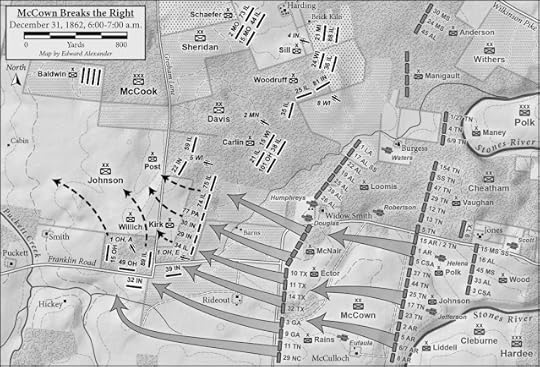 Rains' brigade of McCown's division held the divisional left during the initial assault at Stones River. The whole division struck General Richard Johnson's line before wheeling to the right, a movement which crossed up the brigade lines and so tangled McCown's advance that the following division (Cleburne's) soon found itself in the front line confronting General Jefferson Davis's Federal division as the fighting rolled north towards the Wilkinson Pike.
Rains' brigade of McCown's division held the divisional left during the initial assault at Stones River. The whole division struck General Richard Johnson's line before wheeling to the right, a movement which crossed up the brigade lines and so tangled McCown's advance that the following division (Cleburne's) soon found itself in the front line confronting General Jefferson Davis's Federal division as the fighting rolled north towards the Wilkinson Pike. Another amusing scene occurred at a barn filled with hay inwhich some Federals attempted to hide. On our surrounding it, several of theenemy called out that they would surrender, and coming out gave themselves up.One of our company, however, not being satisfied with the looks of things,grabbed a pitchfork and went to probing in the hay. After several thrusts wewere startled and convulsed with laughter by hearing a Dutchman yell out, “Houldup! Hould up! Mine Gott! I vill give up!” The hay tossed right and left and outrolled the most badly frightened Dutchman I ever saw.
The enemy now threw forward a small body of cavalry to tryand check us but the open field affording an unobstructed view for a longdistance, they were seen in time to give us a chance to rally on our colors. Wethen made a rush at their cavalry who put the spurs to their horses and wentracing after their infantry. We kept up the pursuit for about two miles,forcing their right wing back in such a manner as to almost double it on theirleft. Reaching a heavy piece of fenced woodland and backed by a dense cedarthicket and being nearly out of ammunition, we threw forward a line ofskirmishers as a precaution against ambush.
It was fortunate that we did so for soon rapid firing infront told us that the enemy had rushed reinforcements to try and stem the tideof defeat and that our skirmishers were hotly engaged. Now the command “forward”ran along the line and the boys almost at a double quick moved toward thefiring in front. Soon our skirmishers were seen falling back and then every manseemed to know what was coming and nerved himself for it. Boom, boom, boom,shh, shh, shh, bang, bang, bang! The enemy opened on us with several batteries.But steadily we moved forward until we reached the brow of a small ravine orlarge gully, backed by a dense cedar thicket where, crouched or kneeling not 50steps below us with their guns at a ready was a heavy line of bluecoats. Such acrash of musketry greeted us almost point-blank that it seemed as it no onecould escape. But our nearness and being above them was what saved us- theirshots passed above us.
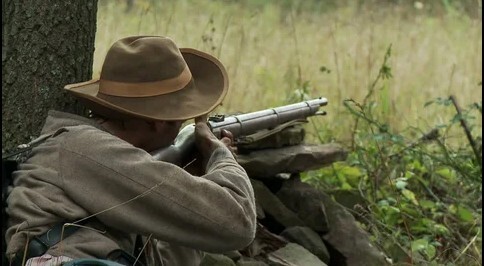 Rains' brigade first struck the right flank of General John Beatty's Federal brigade in the cedars before marching north and running into the 36th Indiana near the edge of the cedars. The 36th Indiana, thinking the Regular Brigade was in their front, marched into the cedars without skirmishers and blundered right into the waiting guns of the 11th Tennessee.
Rains' brigade first struck the right flank of General John Beatty's Federal brigade in the cedars before marching north and running into the 36th Indiana near the edge of the cedars. The 36th Indiana, thinking the Regular Brigade was in their front, marched into the cedars without skirmishers and blundered right into the waiting guns of the 11th Tennessee. The enemy doubtless thought they had wiped us off the face ofthe earth but imagine their surprise when with a mighty Rebel yell we dashedright into their very ranks with our guns loaded and began dealing death muzzleto muzzle. The little gully was soon strewn with dead and dying and it was herethat our brave young General Rains fell, pierced through the heart while theenemy’s colonel commanding their brigade Colonel Forman of Kentucky also fell,pierced by three balls. [Colonel Forman led the 15th Kentucky, aregiment a Colonel John Beatty’s brigade. His body was retrieved by his owntroops later that evening. See “Swallowed by the Cedars: A Day with the 15thKentucky”]
The death of our beloved general seemed torouse the demon of battle in every man and so fiercely did we fight that the enemyagain broke in wild disorder for the cedar thicket in their rear- our brigadein full chase. It was here that I saw one of our boys stick his gun rightagainst a big Dutchman who was in the act of jumping over a pile a dead brushand at the crack of the rifle, the Dutchman nearly tumbled a completesomersault, falling into a small lime pit perfectly dead, his clothes smokingfrom the fire from the rifle. The ball must have cut his heart in twain.
Again, the enemy threw forward a heavycolumn and the fighting that followed was something on the Indian order. Ourammunition having given out completely, Colonel Stovall, now commanding thebrigade, ordered us to rally on the colors. We then marched out of the cedarthicket and took up a position on the brow of the very gully from which we hadbeen fired upon a short time before. The enemy, discovering or guessing thecause of our falling back without replying to their shots, formed in heavycolumn and began to move upon us.
Colonel Stovall, seeing the necessityof holding our ground, rode up to the colors and gave in a voice like a trumpetthe command, “Fix bayonets! Boys, we will try cold steel on them.” It was then,the writer must acknowledge, he felt the need of help and a great deal of help.The enemy must have heard the command, for they halted and we were not sorrythat they did. It was now that we heard a heavy tramping in our rear andlooking back beheld a long line of Confederates headed by “Fighting FrankCheatham” as he was known in the army.
On opening our ranks to let them pass, one of Cheatham’s menremarked, “Let us at them, we’ll give them hell!” I believe that all our boyswere perfectly willing to “let them at them.” In two or three minutes, theyreached the enemy who had again fallen back to the thicket and from the roar ofthe rifles we knew that they were trying to keep their promise. The noise waslike that of a thousand packs of heavy firecrackers turned loose at the sametime. Soon our ears were greeted by the old familiar Rebel yell and we knewthat the enemy was in full flight.
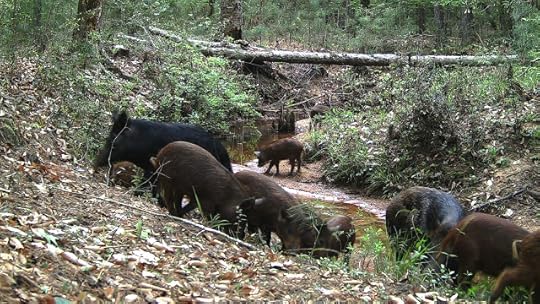 Based on Corporal Smith's recollection, hogs roaming through the cedar forest started to consume the multitudes of dead soldiers while the smoke of battle still hung heavy among the trees.
Based on Corporal Smith's recollection, hogs roaming through the cedar forest started to consume the multitudes of dead soldiers while the smoke of battle still hung heavy among the trees. The fighting now ceased for the day on the part of ourdivision but we soon found that we had a far different enemy to contend with- adrove of wild hogs had commenced to devour the dead and wounded. They seemedperfectly crazed by the taste of human flesh. The writer saw several fightingover the arms and entrails of the dead. The wounded and dead were soon gatheredup and it was necessary to put guards around them with fixed bayonets in orderto keep off the hogs.
The next day, General Bragg, believing we had gained a greatvictory and that the enemy was retreating, but he was partly mistaken. We hadgained a great victory and one to be proud of but the enemy had only fallenback in order to straighten out his line and to be in a better position. On the2nd of January a part of his army crossed the river and taking positionopened up a heavy enfilading cannonade against General Polk’s command. GeneralBreckinridge, with his division, drove the enemy back over the river butencountering heavy odds was in turn driven back with considerable loss. Botharmies now rested, each watching the other. On the night of the 3rd,after having skirmished and fought for five days in the rain and cold, theenemy received heavy reinforcements and General Bragg retreated to Tullahoma.So ended the first Battle of Murfreesboro.

To learn more about the Stones River campaign, please click on the link below to visit the Battle of Stones River page which includes links to all of the 100+ posts I've written about Stones River.
And be sure to pick your copy of my award-winning campaign study Hell by the Acre available through Savas Beatie!
Source:
“AnInteresting Sketch of the First Battle of Murfreesboro, Tenn.” Corporal WalterB. Smith, Co. F, 3rd Georgia Infantry Battalion, MontgomeryAdvertiser (Alabama), June 15, 1902, pg. 5
June 30, 2025
The Perfect Trap at Yorktown: A Vermont Survivor’s Tale
SergeantFrank Rew of the 3rd Vermont served with the Army of the Potomacfrom its beginnings through Appomattox, but his first harsh introduction tocombat didn’t arrive in a large battle but in a fierce skirmish that tookplace on the siege lines of Yorktown in April 1862.
Four companies of the 3rd Vermontwere tasked with crossing the Warwick River at Dam No. 1 and seizing the Confederate rifle pits beyond which their commanders thought had been abandoned. They were quicklydisabused of the notion. “The creek is about six rods wide and into it thebrave fellows dashed, some sinking to the waist and others to the arm pitswhich of course wet much of our ammunition," Sergeant Rew recalled. "When about midway, the Rebelspoured in a blinding volley upon them, mowing them down like grass, but onrushed the rest in the face of 3,000 enemy riflemen and dashing up the bankdrove a whole regiment from their first rifle pit. The odds were too fearfuland every man knew he was fighting against hope. The order to retreat not beingheard amid the din of battle, they fought on and held the trench they hadcaptured for 15 minutes when the order was again; this time, they fell slowlyback.”
This brief action cost Rew’s company27 men killed, wounded, and missing. “I went down at the first firing ofmusketry and helped bring in our wounded. Such a sight I never beheld before. GeneralBrooks says the order was not designed to storm and take the enemy’s works butfor a forced reconnaissance and then to fall back, but our men thought it wasfor that purpose and were bound not to stop short of it.”
Sergeant Rew’s riveting account of what became known as the Battle of Lee's Mills first saw publication in the May 3, 1862,edition of the Waukegan Weekly Gazette, shared with the editors of that newspaperby his parents who were then living in Lake County, Illinois.
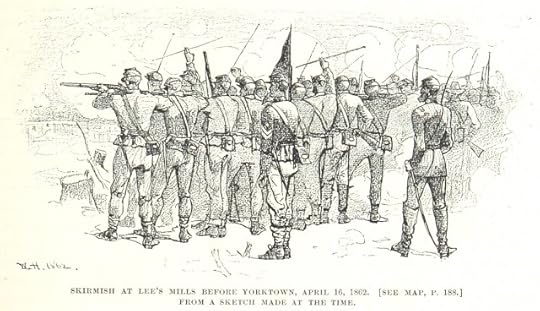 The 3rd Vermont ran into trouble at what became known as the Battle of Lee's Mills fought on April 16, 1862, running into a line of rifle pits held by Brigadier General Howell Cobb's brigade. Two member of the 3rd Vermont would eventually be awarded the Medal of Honor for their heroism at Lee's Mills.
The 3rd Vermont ran into trouble at what became known as the Battle of Lee's Mills fought on April 16, 1862, running into a line of rifle pits held by Brigadier General Howell Cobb's brigade. Two member of the 3rd Vermont would eventually be awarded the Medal of Honor for their heroism at Lee's Mills. BeforeYorktown, Virginia
April 17,1862
My dearparents,
You will see by my handwriting that Iam still in the land of the living, but how fortunate I am to have been thusspared while my poor company is all cut up. Only twelve of those who went overthat fatal creek came out unscathed. But two officers were wounded; Captain [Samuel E.] Pingree received a wound in the hip and had his right thumb shot away besidesmany holes in his clothes. Lieutenant Chandler received a ball in one leg andanother in his right hand. French came out sound though he had many closecalls. As he was loading his gun, a ball struck the bayonet and glanced by hisear else it would have struck him in the face. His clothes were riddled.
Now you want to know the particularsof the fight. Yesterday morning, our brigade was ordered to the front followedby two batteries. The latter opened on the enemy’s works and silenced severalguns. No demonstration was made by the infantry until 3 p.m. when an order cameto the 3rd Vermont to send two companies over the creek as theRebels were supposed to have been driven from their rifle pits in front. Sixcompanies of our regiment had been deployed as skirmishers and those remainingwere Cos. D, E, F, and K. Cos. D and F were chosen to charge across the creekwith Cos. E and K in support.
The creek is about six rods wide andinto it the brave fellows dashed, some sinking to the waist and others to thearm pits which of course wet much of our ammunition. When about midway, theRebels poured in a blinding volley upon them, mowing them down like grass, buton rushed the rest in the face of 3,000 enemy riflemen and dashing up the bankdrove a whole regiment from their first rifle pit. The odds were too fearfuland every man knew he was fighting against hope. The order to retreat not beingheard amid the din of battle, they fought on and held the trench they hadcaptured for 15 minutes when the order was again; this time, they fell slowlyback.
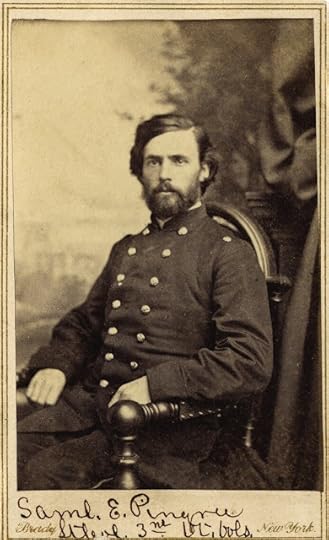 Sergeant Rew's company commander at Lee's Mills was Captain Samuel E. Pingree who was wounded in the engagement; years later, he would be awarded the Medal of Honor for his actions in this engagement. In 1884, he was elected governor of the state of Vermont.
Sergeant Rew's company commander at Lee's Mills was Captain Samuel E. Pingree who was wounded in the engagement; years later, he would be awarded the Medal of Honor for his actions in this engagement. In 1884, he was elected governor of the state of Vermont. The Rebels having gained their second rifle pit had againsent their leaden hail upon them in a perfect storm with deadly effect.Lieutenant Buck of Co. D attempted to rally the men after they reached thefirst rifle pit and make a dash on the second; as he leaped on the other sideof the trench, one of our boys named Eldridge (a noble fellow) raised himselfupon his elbow and said with a smile, “We would follow you if we could, but weare all wounded here,” and fell back. Another of our company named Moses George,fell with both legs broken, but took our cartridges and tore them open for theother boys to load, encouraging them until they were all down and no one leftto use them. There were many similar cases of bravery I could mention if timepermitted. Their praise is in everyone’s mouth.
The Rebels had laid a perfect trap; one regiment being infront and two on each flank which formed three sides of a hollow square withour poor boys in the center. How a man escaped I am at a loss to tell unlessthe enemy thought it was a decoy and dared not follow. Nearly 100 of the fourcompanies of our regiment are either killed, wounded, or missing. The missingare all on the other side of the creek, whether killed or prisoners is notknown. We have 52 wounded men in the hospital who are well cared for.
I went down at the first firing of musketry and helped bringin our wounded. Such a sight I never beheld before. The 6th Vermont wasordered down during the engagement and attempted to cross but were repulsedwith the loss of 100 men. I also assisted in getting off the wounded. GeneralBrooks says the order was not designed to storm and take the enemy’s works butfor a forced reconnaissance and then to fall back, but our men thought it wasfor that purpose and were bound not to stop short of it. Last night, our forcesthrew up works, bearing on the enemy’s fortifications and today the men havebeen busy in filling sandbags. By tomorrow I presume they will be ready toresume the work of death. We have moved our camp 1-1/2 miles today nearer theenemy’s works. I am very tired having been with the wounded all day. If it isthe will of God, I shall still be preserved; if not, His will be done. Willwrite again soon.
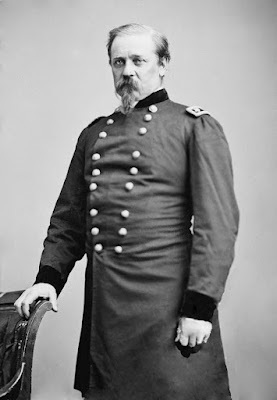 At Lee's Mills, the 3rd Vermont was under the command of Brigadier General William Farrar "Baldy" Smith who led a division.
At Lee's Mills, the 3rd Vermont was under the command of Brigadier General William Farrar "Baldy" Smith who led a division.CampWinfield Scott, Virginia
April 21,1862
My dearparents,
We are occupying the same position aswhen I last wrote but every day has its excitements and time flies rapidly. Theloss in our company proves to be 27 killed and wounded, not as bad as at firstsupposed and 83 in the four companies that went over the creek. Fortunately, 20of our company were out as skirmishers, hence did not go over. We have but 56men- Captain Pingree and Lieutenant Chandler will go home on furlough untilable to resume their duties. Their wounds were not dangerous.
We had an exciting scene the daybefore yesterday which I must say reflected more honor on the Rebels than us.The day after the fight, Quartermaster Craine asked permission to go down undera flag of truce and bury our dead and help our wounded if any remained; thisGeneral McClellan did not grant. On the third day, white flags were raised onthe enemy’s works which created some excitement along our lines. I climbed atree where I could see the meeting of the flags. Major Curry, A.A.G. to General [William F.] Smith, went down from our side and was met by the colonel of the 2ndLouisiana. They asked for a cessation of hostilities for two hours for thepurpose of burying our dead. Of course, they had none of their own to cover.The men had fallen on their side just under their works and our sharpshooterswould not let a man show his head. I say, this does the Rebels credit for theymade the first offer which in itself was humane.
But to return, General Smith would notaccept their first request, but asked permission to go over and do the workourselves. After due consultation, they agreed that the Rebels should bring thebodies partway across the dam and we should receive them and bring them away.The orders were very strict as to who and how many should go. Only 4 wagons and20 men were allowed. The stipulations were that neither side should takeadvantage of the truce for reconnaissance, hence the men were not permitted tocome to the front nor any glasses allowed in our party. A captain andlieutenant were in charge besides the colonel with the flag; Quartermaster Crainealso was in our party.
Some 50 Rebels were employed to bringour poor boys over, all of whom we saw face to face in their wild state. I willmake no comment on the revolting task of receiving the bodies, enough to say itwas awful for they had lain three days in the hot sun and were so changed thatI could recognize but four of our men, one was a sergeant. They brought over 29bodies in all, 22 belonging to our regiment and the rest of the 6thVermont. The retained four of our wounded men as prisoners.
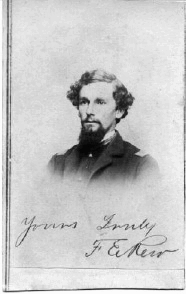 Sgt (later Lt) Frank E. Rew
Sgt (later Lt) Frank E. RewCo. F, 3rd Vermont
We remained together for an hour whilewaiting for teams which gave us the opportunity for conversation. They werevery courteous and even talkative. I found several quite intelligent fellows,one in particular from Georgia. We had a social time, exchanged buttons, andshook hands warmly when separated. How much cordiality he felt I cannot tellbut presume he concluded I was half secesh. I had an object, however, andgained some important facts by the means. Some of their men were well dressedand others quite destitute.
I conversed sometime with a Kentucky fellow who was downcastand nearly sick of his job. Our forces have possession of his old home and heis without friends or means. I asked one man what thought of the Yankees takingboats around Island No. 10 on dry land? He acknowledged it was a fine truck butsaid we could not run our boats through their works here on dry land and askedwhat I thought of their fortifications. I was obliged to acknowledge them veryformidable which is really the fact. They were all fast for trading somethingwith our men and most all brought away something of a trophy.
Our sharpshooters are doing a grand work here and are a greatterror to the Rebels. Every night, our troops throw up entrenchments and now wehave three fine forts which when they are opened will no doubt reduce thosebefore us. It was a saucy trick to build these works right under the enemy’sguns. Our whole line is entrenching strongly and the whole army are using theshovel and axe. Not a night passes without heavy volleys of musketry beingfired back and forth and at intervals the big guns will open. Be assured thisis music, yet I hardly think the general ball will open just yet. I had littleidea of a real siege until I witnessed it here. Yesterday and today, it hasrained hard yet the work goes on.
Source:
Letters fromSergeant Frank E. Rew, Co. F, 3rd Vermont Volunteer Infantry, WaukeganWeekly Gazette (Illinois), May 3, 1862, pg. 2
Daniel A. Masters's Blog
- Daniel A. Masters's profile
- 1 follower



